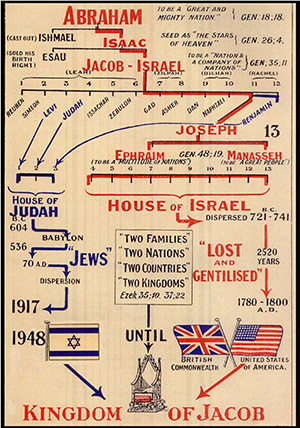Loyalism and British-Israelism
Published in Features, Issue 6 (November/December 2019), Volume 27A divinely sanctioned form of imperialism or an explanation for the apparently beleaguered condition of God’s chosen people?
By Aidan Cottrell-Boyce
The one-time governor of Jerusalem Sir Ronald Storrs made a memorable claim about the potential of Palestine to become a ‘Jewish home’:
‘Enough [Jews] could return, if not to form the Jewish State … at least to prove that the enterprise was one that blessed him that gave, as well as him that took by forming for England a little loyal Jewish Ulster in a sea of potentially hostile Arabism’.
In this statement Storrs said more about British perceptions of Ulster than about British perceptions of Israel. In the early twentieth century, many British lawmakers saw Protestant Ulster—as they saw Israel—as an enclave of godliness and civilisation in ‘a sea’ of hostility. Almost certainly Storrs was also drawing on the biblical topos of Israel, a holy and embattled people, in order to inform his idea of what Jewish Palestine would become and what Ulster was.
This vision of Ulster was certainly shared by the prophetic figures of Protestant loyalism in the twentieth century. In the sermons of the Revd Ian Paisley, the Protestants of Ulster are repeatedly referred to in terms that accentuate their minority status, beset on all sides by the forces of Antichrist. As Margaret Thatcher threatened to impose the terms of the Anglo-Irish Agreement in 1986, Paisley portrayed the prime minister as a latter-day Pharaoh:
‘She is saying to us, “Where is the Lord thy God?”—I have got the Army. I have got the Police. I have got the authority. I have got the Parliament. I have got the backing of the world. I have the great American nation behind me. You defiant little remnant of people you do as I say.’
Meanwhile, Paisley styled himself after Hosea, bemoaning the miscegenation of Protestant Ulster in its ‘marriage’ to the ‘Catholic Republic’ in just the same terms that Hosea used to bemoan the adultery of Israel with the gods of other nations.
Origins of British-Israelism
A small but significant proportion of loyalists during this period took this fertile imagery in a more literal direction. They gravitated towards the ideology of British-Israelism. British-Israelism, as a movement, began in England in the late nineteenth century. Its principal exponents—John Wilson, Edward Hine and Edward Wheeler-Bird—made reference to racial pseudo-science, phrenology and cod philology in order to make the argument that the people of Britain were the descendants of the lost tribes of Israel. By the mid-twentieth century, British-Israelist organisations could claim to have tens of thousands of members in Britain alone. Amongst their membership they included members of the royal family, and George VI openly expressed his belief in British-Israelist doctrine. There were 3,500 branch meetings of one organisation—the British Israel World Federation (BIWF)—held annually. These organisations published a large variety of books, magazines and newspapers.
Scholars have commonly described the phenomenon of British-Israelism as a divinely sanctioned form of imperialism. In the Irish context, however, the topos of British-Israel appears to have stood not for ethnic supremacy but rather as an explanation for the apparently beleaguered condition of God’s chosen people.

Above: The early exponents of British-Israelism made reference to racial pseudo-science, phrenology and cod philology to make the case that the people of Britain were the descendants of the lost tribes of Israel.
Prominent unionist British-Israelists
A number of prominent figures within the unionist community openly avowed their commitment to the British-Israelist doctrine in the mid- to late twentieth century. Robert Bradford, elected as MP for South Belfast in 1974, was also a delegate of the BIWF throughout the 1960s and 1970s. Clifford Smyth was elected to the Constitutional Convention in 1975 and later stood as a parliamentary candidate for the Ulster Unionist Party. In the 1990s and early 2000s he was employed by the BBC as an expert pundit on the Orange Order. He combined these commitments with a role in the BIWF, which itself involved numerous speaking engagements. Nelson McCausland is the latest figure to combine a career in loyalist politics with card-carrying British-Israelism. He was a DUP MLA and was the culture minister for the Stormont Assembly between 2009 and 2011. In October 2008 he spoke at the 89th Congress of the BIWF, and in April 2012 he spoke alongside Michael A. Clarke, Carol Cream, Norman Pearson and David Hilliard at a rally in support of the BIWF in Morecambe. In 2017 McCausland was listed as a voluntary trustee of the BIWF. In April 2019 he spoke at the BIWF annual general meeting at the Auckland Hotel in Morecambe. One prominent British-Israelist of this period, Pastor Alan Campbell, claimed to be a third-generation adherent. In a Christmas sermon, preached at the Open Bible Fellowship in Cregagh in 1988, Campbell described his vision of Ulster:
‘For far too long we have been made to feel ashamed of our Patriotism and Loyalism, and told we should abandon it all when we are born again. The British-Israel Truth refutes this serious error. Britain is part of God’s vineyard, Ulster is our own Promised Land, peopled by the very seed of Israel planted here as a light in darkest Ireland, and we must occupy until Jesus comes.’
It would be tempting to draw a connection between loyalist British-Israelism and other supremacist themes in loyalist thought, but even the most cursory reading of British-Israelist literature gives the opposite impression. British-Israelists in Ireland represented themselves as a poor and embattled minority, beset on all sides by the intrigues of Jesuits, Fenians, Brussels bureaucrats and international socialists. Collectively, these elements combine to form the universal adversary: Babylon.

Above: Logo of the British Israel World Federation.
In his 1972 pamphlet The axis against Ulster, Smyth describes the European Union as a Roman Catholic project designed to facilitate papal hegemony. Evidence for this could be found in Heath’s termination of Stormont rule in 1972. Smyth suggested that the ‘Roman Catholic countries of the EEC’ were ‘putting great pressure on Heath over Ireland’. In 1972 Smyth predicted an EEC-backed military invasion of the UK by the army of the Republic of Ireland. In a later text, Smyth pointed to what he saw as the ‘prophetic significance’ of the ‘abuse and persecution of Ulster Protestants’. The leadership of Sinn Féin, he wrote, was committed to the ‘ethnic cleansing’ of Protestants from Ireland. The intention of the mainstream nationalist parties, Smyth claimed, was to isolate the Protestant minority, to leave them ‘on their own, without political friends or allies’.
Smyth adopts a prophetic mood in his writing, at one point imploring his reader: ‘Pray that God will raise up prophets to speak to the dry bones of Ulster Protestantism! To tell a despised and rejected people that God really loves them.’ Referring specifically to the Irish boycott of Protestant businesses, Smyth suggested that this was in partial fulfilment of Revelation 13, in which it is prophesied that, under the reign of the beast, ‘no man might buy or sell, save he that had the mark, or the name of the beast’. Smyth took this to refer to a situation in Ulster in which only Catholics would be permitted to trade as a result of the boycott [which boycott?].

Above: Prominent unionist politicians such as Revd Robert Bradford, Clifford Smyth and Nelson McCausland have been actively involved in the British Israel World Federation (BIWF) from the 1960s to the present. (Victor Patterson)
The Catholic Church and the USSR—Babylonian forces
Alongside the Catholic Church and the EEC, many British-Israelists saw the USSR as a Babylonian force and thus an antagonist of Ulster-Israel. In the aftermath of the Le Mon bombing in 1978, one British-Israelist magazine—The National Message—suggested that the situation in Ulster was ‘impossible’. The main culprits, they suggested, were the IRA, the Soviet Union and the Irish government, a ‘nefarious brotherhood of iniquity’. The former commander-in-chief of Allied forces in Europe, General Sir Walter Walker, gave an interview to The National Message in August 1974 in which he placed great emphasis on the connection between the IRA and the USSR. Walker suggested that the building of a Soviet embassy in Dublin was designed to provide a ‘back door’ for the KGB to arm IRA militants. The correct understanding of the acronym IRA, meanwhile, was ‘International Revolutionary Anarchists’.
To most, the Catholic Church and the Soviet Union might seem like strange bedfellows. In fact, these twin theories were not as incompatible to British-Israelists as they may have been to non-British-Israelists. It was a commonplace of British-Israelist eschatology during this period that the Soviet Union and the Vatican represented two sides of the same coin. The Soviets were expected to precipitate an onslaught against Palestine, which would bring about the consummation of the prophecies of Revelation 16. The Catholic Church is seen by most Protestant millenarians as the embodiment of Babylon. This is what Robert Bradford MP meant when he declared—at a conference in 1974—that:
‘The problems of Northern Ireland are the result of three things: the Roman Catholic Church, international Marxism and ecumenism. As a British Israelite I believe that scripture can be interpreted and understood very clearly in the light of current events.’
Despite the massed forces of the Catholic Church, the Republic of Ireland and the Soviet Union, British-Israelists remained confident that Loyal Ulster would remain faithful. ‘These are Protestants in the true sense of the word,’ wrote Matthew Browning, the then president of the BIWF, ‘and they are Israel. Loyal Ulster will not be moved. This truth … was the lesson of the siege of Londonderry.’ Nevertheless, the lot of God’s people was expected to be one of hardship. At a BIWF rally in Newtownabbey in 1990, Tom Price preached on the subject of ‘the Furnace of Affliction’. For models of fidelity, he preached, Ulster Protestants should look to their ancestors: Shedrach, Meshach and Abednego.
White supremacy?
British-Israelism is commonly associated with white supremacy. In the American context, these two trends have certainly been linked, but to claim that they are umbilically linked is to misunderstand Protestantism and the biblical topos of Israel. Protestant soteriology almost always situates the godly in the minority. As the Puritan John Norden wrote, ‘the church of God hath been always farre the least part of the world’. The people of Israel, in the biblical context, mirror this experience. They are described not as a superior race but only as a priestly nation, a people set apart. In the main, this separation results not in glory and prestige but in hardship and marginality. The British-Israelists of Northern Ireland did not see their ‘Israelite’ identity as indicative of racial superiority. Rather it functioned as an explanation of their perceived isolation, embattlement and betrayal at the hands of a wicked and perfidious world.
Aidan Cottrell Boyce’s British Israelism in the twentieth century will be published in 2020 by Routledge.
FURTHER READING
M. Barkun, Religion and the racist right (Chapel Hill, 1997).
C. Kidd, The forging of races (Cambridge, 2006).
















